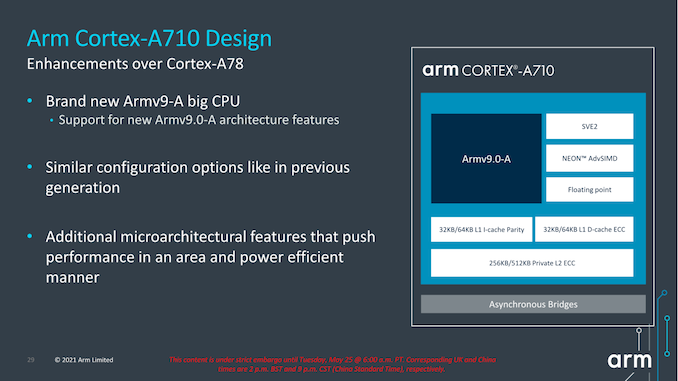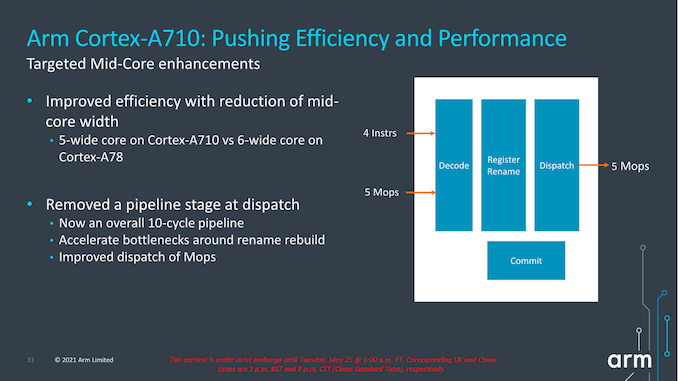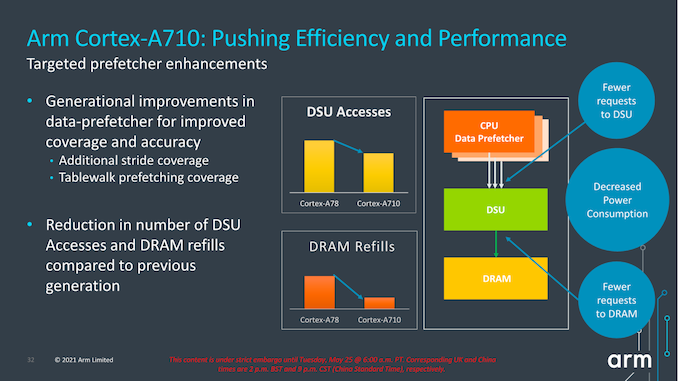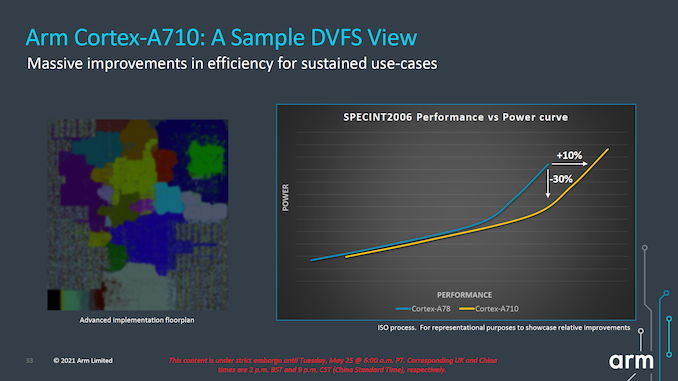Arm Announces Mobile Armv9 CPU Microarchitectures: Cortex-X2, Cortex-A710 & Cortex-A510
by Andrei Frumusanu on May 25, 2021 9:00 AM EST- Posted in
- SoCs
- CPUs
- Arm
- Smartphones
- Mobile
- Cortex
- ARMv9
- Cortex-X2
- Cortex-A710
- Cortex-A510
The Cortex-A710: More Performance with More Efficiency
While the Cortex-X2 goes for all-out performance while paying the power and area penalties, Arm's Cortex-A710 design goes for a more efficient approach.
First of all, the new product nomenclature now is self-evident in regards to what Arm will be doing going forward- they’re skipping the A79 designation and simply starting fresh with a new three-digit scheme with the A710. Not very important in the grand scheme of things but an interesting marketing tidbit.
The Cortex-A710, much like the X2, is an Armv9 core with all new features that come with the new architecture version. Unlike the X2, the A710 also supports EL0 AArch32 execution, and as mentioned in the intro, this was mostly a design choice demanded by customers in the Chinese market where the ecosystem is still slightly lagging behind in moving all applications over to AArch64.
In terms of front-end enhancements, we’re seeing the same branch prediction improvements as on the X2, with larger structures as well as better accuracy. Other structures such as the L1I TLB have also seen an increase from 32 entries to 48 entries. Other front-end structures such as the macro-OP cache remain the same at 1.5K entries (The X2 also remains at 3K entries).
A very interesting choice for the A710 mid-core is that Arm has reduced the macro-OP cache and dispatch stage throughputs from 6-wide to 5-wide. This was mainly a targeted power and efficiency optimization for this generation, as we’re seeing a more important divergence between the Cortex-A and Cortex-X cores in terms of their specializations and targeted use-cases for performance and power.
The dispatch stage also features the same optimizations as on the X2, removing 1 cycle from the pipeline towards an overall 10-cycle pipeline design.
Arm also focuses on core improvements that affect the uncore parts of the system, which take place thanks to the new improvements in the prefetcher designs and how they interact with the new DSU-110 (which we’ll cover later). The new combination of core and DSU are able to reduce access from the core towards the L3 cache, as well as reducing the costly DRAM accesses thanks to the more efficiency prefetchers and larger L3 cache.
In terms of IPC, Arm advertises +10%, but again the issue with this figure here is that we’re comparing an 8MB L3 cache design to a 4MB L3 cache design. While this is a likely comparison for flagship SoCs next year, because the Cortex-A710 is also a core that would be used in mid-range or lower-end SoCs which might use much smaller L3 caches, it’s unlikely we’ll be seeing such IPC improvements in that sector unless the actual SoCs really do also improve their DSU sizes.
More important than the +10% improvement in performance is that, when backing off slightly in frequency, we can see that the power reduction can be rather large. According to Arm, at iso-performance the A710 consumes up to 30% less power than the Cortex-A78. This is something that would greatly help with sustained performance and power efficiency of more modestly clocked “middle” core implementations of the Cortex-A710.
In general, both the X2 and the A710’s performance and power figures are quite modest, making them the smallest generation-over-generation figures we’ve seen from Arm in quite a few years. Arm explains that due to this generation having made larger architectural changes with the move to Armv9, there has been an impact in regards to the usual efficiency and performance improvements that we’ve seen in prior generations.
Both the X2 and the A710 are also the fourth generation of this Austin microarchitecture family, so we’re hitting a wall of diminishing returns and maturity of the design. A few years ago we were under impression that the Austin family would only go on for three generations before handing things over to a new clean-sheet design from the Sophia team, but that original roadmap has been changed, and now we'll be seeing the new Sophia core with larger leaps in performance being disclosed next year.















181 Comments
View All Comments
mode_13h - Wednesday, May 26, 2021 - link
> I do not know what else and why would anyone hate x86 processors from Intel and AMDLove & hate don't enter into it, for many of us. Based on our understanding of the tech, we recognize that x86 is fighting a losing battle. Apple is merely interesting as the foremost of x86' competitors.
> believe SPEC and Apple marketing PR.
There are plenty of Mac app benchmarks now, between x86 and ARM-based Macs. It's not just the SPEC scores and PR.
> People are using old school Xeon for home server
Sure. More power to them! The picture gets more complicated for laptops, though.
> to play damn latest games with community patches
You can only do that with some games, and eventually you have to start dialing back the quality settings, when you go back far enough.
For sure, x86 will be with us for at least another decade, in some fashion and degree. And the PC gamer will probably be one of the last holdouts.
> Why would anyone hate the only processing standard ...
Since you view this in terms of love/hate, why do you seem to hate ARM?
> Yep they are dumb and ignorant for sure.
Who said that? I think you're projecting.
mode_13h - Wednesday, May 26, 2021 - link
Do you understand thath GeoffreyA was being sarcastic? I think he was poking fun at the very pitched battle that you seem to be walking right into!Silver5urfer - Wednesday, May 26, 2021 - link
Another bs as usual, show me any AT Andrei bench here which shows how that garbage M1 scales in SMT, he never includes that CPU in SMT / HT benchmarks and only in ST it shows up showing some perf. And it's not even breaking any AMD or Intel CPU, with TGL Intel clearly demonstrated they are ready for AMD, forger Apple.64Core Mac Pros ? haha lmao you think logic and transistors simply can expand as long as Apple can buy shills out, you have look at the density of the chip and the uArch scaling PLUS power planes for such huge amount of cores AND the Power envelope.
M1 loses out AMD BGA processors and M1X, M2 do not exist today. We can also talk how AMD Genoa is going to increase cores to 80C and if you add SMT on that with on-die Chipset HBM TSMC 5N, it's a bloodbath for HEDT. Period. So Ryzen 5000 will smash the M1 to smithereens and blow it's ashes into air, wait for the Threadripper based on Milan to see even more catastrophic destruction of the M1, how are you even generalizing these high core count AMD and Intel CPUs on all computing devices, smells massive pile of dumbness.
I wonder what x86 did to you to hate it so much, it brought PC to masses, and it gave you the power of a computer from big rooms to your own room and now we have DIY with full socketed HW to use, ARM garbage has no consumer end ddevices which are popular enough. One can buy the Fujitsu A64FX but it;s super expensive, and Graviton 2 is AWS only, Ampere announced full custom, so expect not possible to buy anytime soon and their old 80C platform is now outdated, what is that ARM is giving and empowering you ? the iPad you used to type or the iPhone ? which have zero filesystem access or the M1 which has no user replaceable components.
mode_13h - Wednesday, May 26, 2021 - link
> I wonder what x86 did to you to hate it so muchTech is just a tool. I started out using MS DOS and then I moved on to Windows and Linux. I didn't hate DOS, but it had outlived its usefulness for me.
> ARM garbage has no consumer end ddevices which are popular enough.
Laptops, so far. Mini PCs are probably just around the corner. Mediatek is licensed Nvidia's GPU IP and has talked about building ARM-based gaming machines.
Intel and AMD could also get into the ARM race, and they could eventually make socketed processors. Certainly, any server processors will be socketed, but I mean for DIYers.
melgross - Thursday, May 27, 2021 - link
You have serious problems.mdriftmeyer - Friday, May 28, 2021 - link
Genoa is known already at 96 cores and patents have them up to 128 cores.The_Assimilator - Wednesday, May 26, 2021 - link
According to you ARM-bros, x86 has been dead every year for the past two decades. So excuse me if I don't put much stock in your particular brand of wankery - especially since Arm IPC improvements have hit a wall at the 3GHz mark.mode_13h - Wednesday, May 26, 2021 - link
> every year for the past two decadestwo decades ???
> Arm IPC improvements have hit a wall at the 3GHz mark.
Yeah, it's a fair point but also kind of irrelevant. Wider, shallower cores tend to clock lower. For mobile and servers, that works out better, since perf/W is a key metric for them. It's mostly just desktops and workstations where you have the luxury of clocking as high as you want. Even HPC is really starting to focus on energy-efficiency.
As for the relevance of IPC and clocks, what really counts is single- and multi- thread performance. The user just cares how fast it goes and potentially how much power it burns or heat it churns out.
GeoffreyA - Thursday, May 27, 2021 - link
It's interesting to see whether Intel and AMD will ever dial back the clocks in their quest for wider, weightier cores.mode_13h - Saturday, May 29, 2021 - link
Well, AMD's Zen cores have never clocked as high as Intel's, but Zen2 and Zen3 have been enjoying more perf/W and are also wider than Intel's. For Intel's part, they added more width in Sunny Cove.Increasing clock speed is a fairly reliable, straight forward way to raise performance over a wide variety of workloads. It's just not great in perf/W.
And to the extent that narrower cores use less silicon, that make them cheaper to produce.